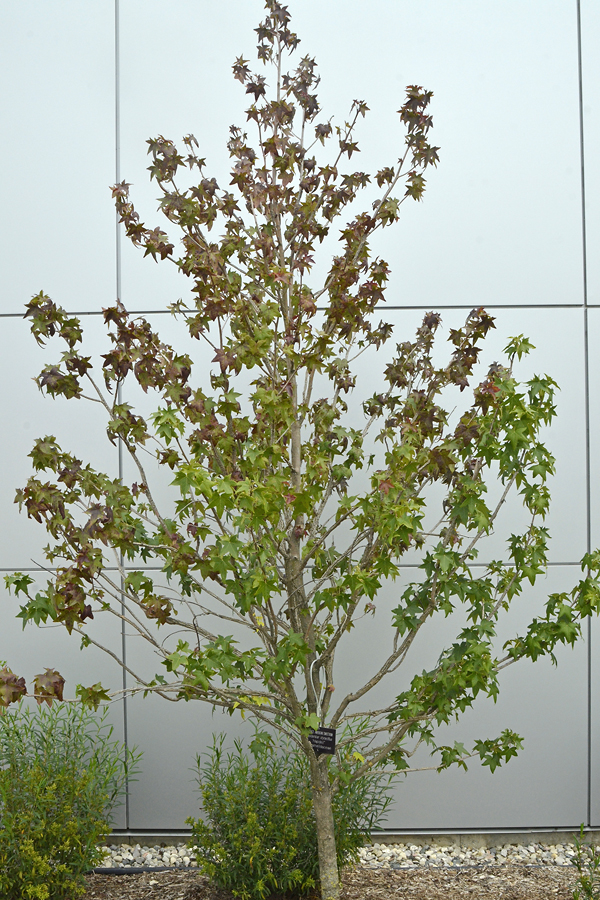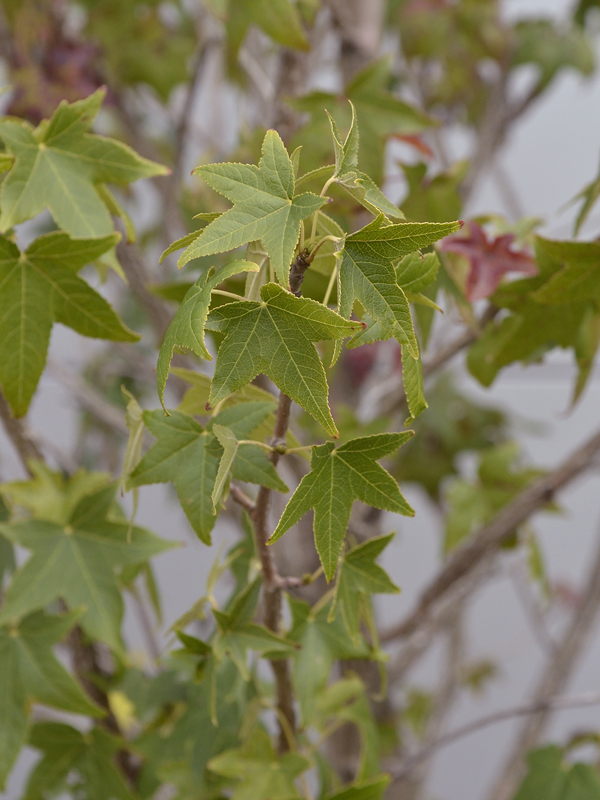
Woody > Liquidambar > Liquidambar styraciflua > Liquidambar styraciflua 'Hapdell'
Liquidambar styraciflua
'Hapdell'
American Sweetgum
Origin: Eastern United States and Mexico.
| Family |
| Hamamelidaceae |
| Genus |
| Liquidambar |
| Species |
| styraciflua |
| Cultivar |
| 'Hapdell' |
| Category |
| Woody |
| Type |
| Tree (deciduous) |
| USDA Hardiness Zone |
| 5 -9 |
| Canadian Hardiness Zone |
| 4a |
| RHS Hardiness Zone |
| H3 - H7 |
| Temperature (°C) |
| 29 -(-1) |
| Temperature (°F) |
| 20 -30 |
| Height |
| 20-30 m |
| Spread |
| 15-20 m |
Photographs
Description and Growing Information
Flowering Period
| General Description |
| Liquidambar styraciflua is a deciduous shade tree commonly referred to as American Sweetgum. This common low maintenance tree is native from Missouri to South America and Mexico. The usual growing conditions for this shrub is a moist low lying area making it most commonly in the South-East corner of the United States. |
| Landscape |
| Parks. |
| Cultivation |
| Best grown in average moisture but well drained soils in full sun. This specimen can handle a wide variety of soils but prefers deep moisture rich soils. Must be in part to full sun (cannot tolerate full shade) recommended to avoid alkaline soils. |
| Shape |
| Pyramidal in shape but develops a rounded crown at the top as it matures. |
| Growth |
| Medium |
| ID Characteristic |
| Liquidambar styraciflua commonly grows to the height of 20-30 m. |
| Pests |
| No serious pest or disease problems reported for liquidambar styraciflua. Small accounts of webworm and caterpillars, borers and scale that may cause problems. |
| Habitat |
| Commonly found along the South-East United States border. |
| Bark/Stem Description |
| Gnarled and is regularly greyish-brown colour. The bark also appears red on the younger foliage. |
| Flower/Leaf Bud Description |
| Large dark green and reddish coloured buds that are conically shaped. The buds become very large starting at about 1 cm long and eventually swelling into a tear shaped bud. |
| Leaf Description |
| Star shaped, glossy, dark green leaves with pointed lobes. Each leaf is roughly 10-17 cm in width and has 5 or 7 points or lobes. The leaves turn brilliant yellow, orange, purple and red into the autumn season. |
| Flower Description |
| Flowers in April-May producing a non-showy cluster of yellowish-green flowers. |
| Fruit Description |
| Round hard and bristly growing in clusters that are roughly 4 cm across. |
| Colour Description |
| Has showy autumn interest with leaves changing to red, purple, yellow, and orange in colour. |
| Texture Description |
| Medium. |
| Notable Specimens |
| The Gardens of Fanshawe College, London, Ontario, Canada. Mount Forest United Church, Mount Forest, Ontario. |
| Propagation |
| Seed should be collected in fall. The capsule-like seed pod contains two winged seeds inside (similar in shape to a samara). The pods need to be soaked for a week to help release the seeds inside. Can be sowed in soil in Spring or Autumn. Although a three month stratification in recommended. |
References
Missouri Botanical Garden Website, World Plants Website, The Manual of Woody Landscape Plants.


